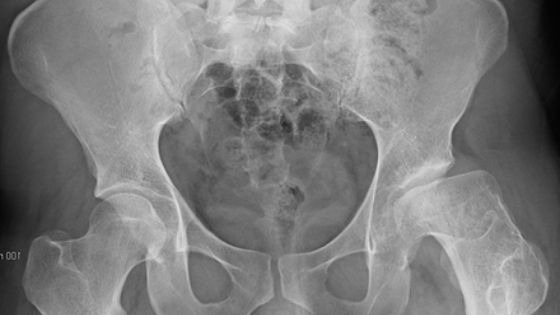My Hips are Uneven, Why? Causes and Treatments

Do you have uneven hips? Do you have one hip that sticks out more than the other? Does it make your clothes fit oddly? Do you feel like a bit of an oddball if this is the case for you?
Well, don't worry! There are ways to fix this problem. If your hips are uneven and it's bothering you, there are some things you can do about it.
Why are your hips uneven?
The answer is hip dysmetria. Hip dysmetria causes a lateral pelvic tilt. This is a functional leg length discrepancy, and dysfunction can cause it in your hips. It can also be caused by one leg being slightly shorter than the other.
Usually, when there is a neck adjustment issue, this will cause the shoulders also appear uneven with a twist. For example, the lower shoulder on the same side as my higher hip is poking out of its hiding place like an outlaw trying not to be caught!
This type of hip dysmetria is called long bone dysmetria because it's related to the growth plates. It usually presents uneven shoulders too. Each physis has its own growth potential based on its age.
What are the symptoms of hip dysmetria?
Clinical manifestation of structural leg length discrepancy including irregular and unstable gait in addition to the aesthetic impact.
In these patients, tipping the pelvis off-center or tilting their spine to compensate for an unsteady gait occurs. On the other hand, dysmetrias greater than 2.5 cm usually produces back pain
The usual symptoms are:
- Scoliotic posture (spine deviated to one side).
- Gait disturbance.
- Painful walking.
Causes of True Hip Dysmetria

Various reasons are causing one leg to be shorter than the other, but your doctor will need to make the diagnosis. The most common causes of leg length discrepancies or lateral pelvic tilts are:
Congenital malformations (agenesis).
They can cause poor spine alignment or malformations in different parts of your lower limbs, or your hip, or even in your knees. In addition, some babies are born with the condition that makes their hip dislocate. It is called hip dysplasia, and it happens for unknown reasons.
Children need to be treated early so that they don't have problems later in life. In addition, early treatment can keep the problem from getting worse when the child grows up.
Adolescent idiopathic scoliosis
Juvenile idiopathic scoliosis is a condition that affects children between the ages of 3 and 9, causing them to develop an abnormal curvature in their spine. This curving causes one side of their spinal column to bend like an S or C shape.
Perthes disease.
Perthes disease is when the head of your femur does not grow well because you didn't have enough blood supply during childhood.
Accidents or trauma
You can suffer hip dysmetria because of traumatic hip dislocations, accidents, or trauma with severe bone lesions.
After some surgeries
You can experience hip dysmetria after surgical interventions of your femoral implant, in which the surgeons generally must lengthen this operated area to improve stability.
How can you diagnose hip dysmetria?
What can you do if your hips are uneven? If you suspect you have congenital causes, early diagnosis is usually made by assessing intrauterine manifestations on ultrasound. To diagnose an irregularity, you should perform a general assessment while you're in underwear to assess skin aspects, the length of the upper limbs, facial symmetry.
- In the first year of your life, you should have a simple radiological examination to see if you have any dysplastic phenomena.
- You will often be asked to get an x-ray on your hips to check for something wrong with them.
- Conventional radiology is the most accurate method because it allows the doctor to assess an axis without magnification. They can examine limb alignment through conventional radiology.
Studies like these will allow you to understand your deformity more and give you a way of correcting it. They will also help you to get back the ability you may have lost due to your condition. Studies like these will show you the type of deformity you may have and tell you how to correct it.
How can a doctor treat dysmetria?
I had uneven hips, and I was wondering what you could do about that. You can get your hips treated depending on the magnitude of the difference. If it's less than 1 cm, you're okay, but you will need to be checked up to ensure you don't have any problems.
- Discrepancies of 1-3 cm can be due to differences in the height of stretchers.
- Doctors recommend surgery for any dysmetria greater than 3 cm. They can use epiphysiodesis or lengthening techniques to treat those with a prognosis between 3 and 7 cm., but anything over that is usually treated by doing it in one or more surgical stages.
- In cases of severe deformities, with a prognosis of severely impaired mobility from sudden prosthetic limb loss or long-term residual chronic injury to the patient's natural limbs, amputation can be an option for adapting quickly and efficiently.
How to disguise uneven hips
Pelvic clock exercise
The pelvic clock exercise is a great way to be active while combining the self-care that's so important for women.
How to perform the exercise: Bring your belly button down towards your spine and keep it there, tilting at 12 o'clock with your pubic bone pressed into 6 o'clock when rotating side to side.
This will stretch tight hip flexors and work out those tense muscles in both hips and abdominals!
Standing reverse leg raises
Stand in front of a chair and grab it with both hands, lifting your right leg behind you slowly (keep your leg straight). Hold the tension for as long as is comfortable before lowering your leg again to repeat on this side, then switching over to do the same thing but with your left leg out behind you.
Breathe steadily while maintaining an upright posture, and let yourself know that no matter how difficult these exercises are now- they will help rebuild endurance later!
Treatment of a false uneven hip or short leg with integral osteopathy
Osteopathic treatment involves adjusting the body's muscles and joints to normalize muscle length, improve mobility, and help relieve joint pain.
Thus, exploration of these areas is essential to establish a presumptive diagnosis. Sacroiliitis may be associated with dysmetria, and the same applies to false sciatica or pyramidal syndrome.
Osteopathic sessions should be comprehensive as they affect all of the joints and organs in the digestive system. However, as a general rule, one or two sessions are enough to bring the body back to balance.
Treatment of a true short leg or uneven hip with shoe lifts
If there is a greater difference in length between the two legs, or if insoles have typically been helpful for someone not currently in a cast, lifts or insoles may be useful.
Before inserting an insole or lift device, it is advisable to correct any previous injuries or dysfunctions with integral osteopathy.
Your trusted orthopedist will perform a biomechanical study of your hip bones and your gait to find the insole that suits you best.
Shoes with lifts to fix dysmetria
Dysmetria is when one leg is shorter than the other, with a difference of 1-2 centimeters between them. You can see this by dragging one trouser leg more so that it drags on the floor, and there will also be greater wear to this shoe as opposed to another worn down from use or just newer in comparison.
Whether acquired or congenital, dysmetria is not a serious problem as long as it’s corrected in time. It can be caused by accident or congenital disability. In some instances, this dysmetria resolves itself over time, and the body becomes accustomed to the imbalance. However, if your change in length exceeds 1 cm, you will need to find
Sneakers with elevation
If you fix dysmetria in time, it can have a beneficial effect on our daily life. This phenomenon does not always cause problems in our activities if the body itself solves it by itself.
In most cases, the difference in muscle mass between one leg and the other makes it impossible to do sports healthily and comfortably. In addition, a fracture in the ankles, feet, or hips will cause certain problems in the long run due to the postures that the patient will adopt without realizing it, but which will cause them to lose muscle mass.
In cyclists, this dysmetria is even more accentuated because as there is more muscle mass in one leg, there will always be one of the two that suffers more, producing an overload during pedaling. This dysmetria in lower limbs (femur, tibia, or fibula) will affect the back considerably. To really know in which leg we have this difference more acute, it is enough to know with which leg we make a greater effort when pedaling.
Before going to the operating room, there are many alternatives to improve performance in sport, thus gaining quality of life. For example, sneakers with lifts can reduce fatigue and prevent muscle pain while exercising. In some cases, it is common to place an external lift. However, this solution is ineffective because the tread is not natural and causes the foot to slide more on the pedal.
Conclusion
If you want to fix your uneven hips, try these things! First, stretch out the tight hip with a few gentle stretches. This will help loosen up the muscles and reduce some of the discomforts that make it hard for you to walk or sit comfortably.
You can also buy clothing specifically designed for asymmetrical bodies - they're made from fabric that drapes more evenly across both sides of your body. Hence, everything fits as well on one side as it does on the other.
Finally, if none of this works for you, have an orthopedic doctor look at what's going on to determine whether surgery is necessary. Remember though- there are many ways to live life without having perfect symmetry all around! (Trusted sources 1*, 2*, 3*)
Medically reviewed and approved by Nataniel Josue M D.
